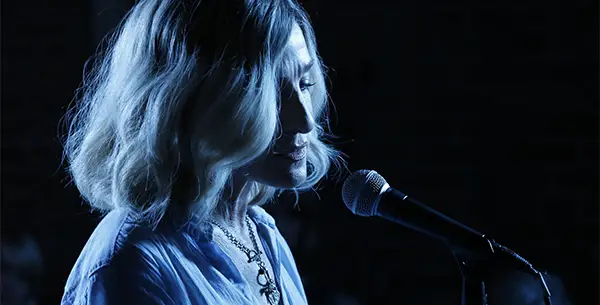Here and Now (originally titled Blue Night) lacks the right intention to push the movie that Fabien Constant wanted to achieve. Clunky and at times, confusing, Here and Now fails to give Sarah Jessica Parker the chance to dive deep into herself and give the emotional performance she was hoping for. Instead, the movie shows the random moments of her day that could happen in New York and comes across as 98-minutes of the first act of a movie you don’t want to see the rest of.
Vivienne (Parker), a successful touring singer is about to celebrate 25 years performing at a local club. On the eve of her performance, she visits a doctor to figure out the cause of her constant headaches, to learn that she has a brain tumor and 14 months to live. She goes on with her day, defecting the news but often finds herself overwhelmed and lost. Her career has pushed the ones closest to her away, and as she struggles to process the news herself, she struggles more to ask for the support that she needs from those in her life.
Wrong Notes
Hoping to create the New York City version of Agnès Varda’s Cleo from 5 to 7, Here and Now fails to translate the emotional value of Varda’s original. In an attempt to create vignettes of Vivienne’s day that convey the shift in how she sees herself and the world, the perspective and style of the movie makeS the chosen moments feel arbitrary and unnecessary. From a shaky hand-held camera to large sweeping pans and tight close-ups, it was hard to settle into the sentiment of the movie.

Vivienne forgets a shopping bag in the back of a Lyft. She calls the driver, Sami (Waleed Zuaiter), and the camera zooms in on his eyes and cuts to a close-up of his mouth as he talks to her. Suddenly it feels like you are watching Taken, and in a strange twist, Vivienne is about to be kidnapped in an attempt to recover her dress. Camera choices like these constantly throw the tone of the movie off, but fortunately, there are strategically timed scenes of Vivienne staring pensively to bring you back in.
As if to combat the drastically different perspectives throughout, obvious designated dramatic scenes try to tie the movie together. She stands on a bridge and looks over the water. And of course, while she’s doing that, an old woman comes up to her and says something crazy and irrelevant. After a stressful exchange with her mother (Jacqueline Bisset), Vivienne walks into her room, closes the door behind her and leans on it as she sighs and looks upward.
While there is no harm in choreographing scenes to evoke emotion and these types of scenes have worked in so many other movies, in Here and Now they feel empty and useless. There is no underlying feeling that is enhanced, it is just there because its supposed to be there and make you feel something.
While it is believable that someone like Vivienne, career driven to the point of isolation, would struggle to share that she’s terminally ill to the people in her life, it’s hard to believe she knew any of these people at all. Ben (Common) a friend and colleague for two decades, yet their moments together are awkward and feel like they just met and are trying to be chummy.
With members of her family, it’s even worse. Exchanges with Vivienne and Jeanne, her mother, are uncomfortable. At one point Vivienne hugs her mother tight, lovingly and then takes her mom and puts it around her. In a childlike and playful way that seems unusual for Vivienne and that part of her is never seen again.
Here and Now: Conclusion
New York in so many ways is the perfect place for an adaptation of Cleo from 5 to 7. The nuances of the city and the chance interactions for a woman in Vivienne’s situation are endless. However, it seems there was too much reliance on the potential of the moments and nothing to guide Vivienne into them.
Have you seen Here and Now? Tell us your thoughts in the comments below!
Here and Now will be in theaters in the US and VOD on November 9th, 2018.
Does content like this matter to you?
Become a Member and support film journalism. Unlock access to all of Film Inquiry`s great articles. Join a community of like-minded readers who are passionate about cinema - get access to our private members Network, give back to independent filmmakers, and more.